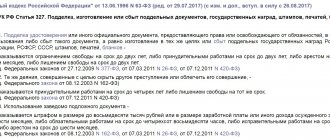ST 325 of the Criminal Code of the Russian Federation.
1. Theft, destruction, damage or concealment of official documents, stamps or seals, committed out of mercenary or other personal interest, is punishable by a fine in the amount of up to two hundred thousand rubles or in the amount of the wages or other income of the convicted person for a period of up to eighteen months, or by mandatory labor for a term of up to four hundred eighty hours, or correctional labor for a term of up to two years, or forced labor for a term of up to one year, or arrest for a term of up to four months, or imprisonment for a term of up to one year.
2. Theft of a citizen’s passport or other important personal document is punishable by a fine in the amount of up to eighty thousand rubles, or in the amount of the wages or other income of the convicted person for a period of up to six months, or by compulsory labor for a term of up to three hundred sixty hours, or by correctional labor for a term of up to one year, or arrest for up to three months.
3. Theft of excise stamps, special stamps or marks of conformity protected from counterfeiting is punishable by a fine of up to two hundred thousand rubles or in the amount of the wages or other income of the convicted person for a period of up to eighteen months, or by forced labor for a term of up to two years, or by imprisonment. for the same period.
Commentary to Art. 325 Criminal Code
1. The three elements of crime provided for in different parts of the commented article have differences in subject, objective and subjective aspects.
2. Signs of the first main composition (Part 1): a) subject - official documents, the characteristics of which, in contrast to Art. 324 of the Criminal Code is not specified by an indication of the granting of rights or exemption from obligations, as well as seals and stamps that are intended for making impressions on documents. The stamp is usually placed in the upper left corner of the document and carries a notification load. The seal is intended to certify the authenticity of the document and is placed next to the signature of the official; b) act in the form of an action - alternatively theft, destruction, damage, concealment. Theft is formed by the seizure and (or) circulation of an object in favor of the perpetrator or other persons. Destruction is an action leading to the fact that an object becomes unidentifiable. Damage means causing harm to an object, which, as a general rule, precludes its intended use. Concealment constitutes concealment of an object, causing the impossibility of its use by interested persons; c) the presence of selfish or other personal interest (to obtain a certain material benefit, to take revenge on an official, to facilitate the commission of another crime, etc.).
3. The second and third main compositions are characterized by: a) special items. In Part 2, this is alternatively a passport (general civil, foreign, diplomatic, official, sailor) or other important personal document. The importance of a document is determined in each specific case based on the fact that it confirms the rights of its owner or contains information about him, except for information that constitutes his personal or family secret. Part 3 includes excise stamps, special stamps and marks of conformity protected from counterfeiting (see commentary to Article 171.1 of the Criminal Code); b) an act consisting of theft of the named objects. Their subsequent destruction, damage or concealment does not require additional qualifications; c) one sign of the subjective side - direct intent. For qualification under Parts 2 and 3 of Art. 325 of the Criminal Code, it must be established that the person was aware of the properties of the stolen items and wanted them out of the possession of the owner (possessor).
The Supreme Court dealt with economic crimes
Today the Plenum of the Supreme Court of the Russian Federation adopted the Resolution “On judicial practice in cases of fraud, misappropriation and embezzlement.” Let us remind you that the draft document was considered on November 14, but it was sent for revision, as a result of which minor editorial and technical corrections were made to the text. In addition, the resolution was supplemented by paragraph 34, indicating that if the actions of a person during fraud, embezzlement or embezzlement, although formally containing signs of the specified crime, but due to their insignificance did not pose a public danger, then the court should terminate the criminal case on the basis of Part 2 of Art. . 14 of the Criminal Code of the Russian Federation.
Earlier, regarding the issue of when the fraud ended, Mikhail Kiriyenko, a partner at Kovalev, Ryazantsev and Partners, noted that such wording is categorically unacceptable. This approach, according to the expert, contradicts the concept of theft, since seizure itself does not make it possible to use and dispose of someone else’s property. He explained: “It seems that this is an option for operational services. If this approach remains, it will be a change in the criminal law norm through the interpretation of the RF Armed Forces, which is both unreasonable and increases the punitive component of Art. 159 of the Criminal Code of the Russian Federation.”
You may like => Transport Card for Schoolchildren How to Get
So, the first two general remarks. 1) calling the resolution new is a stretch. It retains approximately 70% of the old text, and is supplemented mainly by interpretations of fractional frauds with which the Criminal Code has grown. 2) As one of my wise friends says: “It didn’t get better, it got different.” In this case, this is not entirely true. In the new PPVS (hereinafter - PPVS No. 48), unlike the old one (hereinafter - PPVS No. 51), there are no several very significant, frankly unsuccessful formulations that opened the gateway to terrible arbitrariness, as well as simply stupid blunders in the spirit of shares as documentary bearer securities ( for the last special thank you, because I didn’t have the strength to explain to the students that they even wrote something like that). The plenum, as usual, ignored complex and high-tech topical issues: real estate and other objects that have changed in regulation in the Civil Code, cryptocurrency and other virtual things, financial instruments, corporate affairs, and also traditionally failed to cope with payment cards. Probably, given the current lag of criminal justice from other areas, this should be recognized as not the worst option. Otherwise we would risk getting some senseless freak. We take the text of PPVS No. 48 as a starting point and move along it.
As a preamble, we should explain why we are comparing both decisions. Let me remind everyone that acts of interpretation of the highest court are considered in relation to the historical moment, since in this case the uniformity of judicial practice, which the Resolution is intended to serve, ensures historical interpretation as well. Thus, if there was something in the PPVS, but disappeared, this directly indicates to the law enforcement officer that the Supreme Court requires this practice to be abandoned as incorrect.
“The explanation regarding the method of theft of other people’s property in the field of computer information has been excluded from paragraph one,” Khomitskaya said. Noting that in current law “there is no clear answer to the question of whether such interference is an independent method of fraud in general.”
1. Draw the attention of the courts to the fact that the methods of stealing someone else’s property or acquiring the right to someone else’s property during fraud, liability for which arises in accordance with Articles 158.1, 159, 159.1, 159.2, 159.3, 159.5 of the Criminal Code of the Russian Federation, are deception or abuse of trust, under the influence of which the owner of the property or another person transfers the property or the right to it to another person or does not interfere with the seizure of this property or the acquisition of the right to it by another person.
Khomitskaya announced the exclusion from the final version of the draft resolution of that version of paragraph 6, which defined the place where fraud with non-cash funds was committed as “the actual location of the guilty person.” In the final version, they were asked to consider “the location of the bank (its branch) or other organization in which the owner of the funds opened a bank account or kept records of electronic funds.” And based on this, the courts must decide the issue of territorial jurisdiction of a criminal case.
“It seems to us, however, that the establishment of this circumstance should not in any way affect the qualification of fraud as a completed act and, as a consequence, the determination of the punishment for it,” the judge said, explaining that such a position “is supported by the majority of judges of the judicial panel for criminal cases.” "
Second commentary to Art. 325 of the Criminal Code of the Russian Federation
1. Article 325 of the Criminal Code contains three independent elements of crime.
Part 1 provides for liability for encroachment on items of the organizational management system - stamps, seals, excise stamps and marks of conformity. Part 2 provides for liability for the theft of a citizen’s passport or other important personal document. Part 3 contains signs of another independent crime - the theft of excise duty stamps, special stamps or marks of conformity protected from counterfeiting.
2. Subjects of the crime provided for in Part 1 of Article 325 of the Criminal Code.
Official documents - see: commentary on Article 324 of the Criminal Code.
Stamps are a manual printing form used in the production of documents, intended for the production of impressions. Mandatory features of the stamp are the details of the subject, the date of issue and document number, and the purpose of the stamp. Seals are cliches with cut-out signs indicating the details of an enterprise, institution or organization.
The shape of seals and stamps does not matter. Their significant difference depends on their purpose. Stamps are objects that define the characteristics of the subject of management and confirm the inclusion of a document in office work. Seals not only determine the characteristics of the subject of management, but also confirm the legitimacy of the document and certify the legal significance of the information contained in it.
3. The objective side of this crime is characterized by alternative signs - theft, destruction, damage, concealment.
The theft of the above items consists of unlawful, gratuitous seizure of them (withdrawal or conversion for one’s own benefit or the benefit of others). The form of the abduction does not matter for the objective side of the crime in question.
Damage to these items consists of bringing them into a state unsuitable for their intended use.
Concealment of official documents, stamps or seals consists of performing such actions as a result of which these items are withdrawn from official circulation and become inaccessible (or difficult to access). This crime is completed from the moment any of these actions are committed.
4. Its subjective side is characterized by direct intent.
5. The subject of the crime is a person who has reached the age of 16 years.
6. Part 2 art. 325 of the Criminal Code provides for liability for the theft of a citizen’s passport or other important personal document.
A passport is an official document of the established form that identifies a citizen. Another important personal document is any personal document, the presentation of which gives a person rights or relieves him of obligations, and also has another legal meaning, since it determines the person’s position in civil, family and other legal relations. Such documents include, for example, a military ID, a document on education, a promissory note, a letter acknowledging paternity, a certificate of marriage (or divorce), and others.
7. The objective side of this crime is limited to the sign of theft of a document from a citizen. This feature distinguishes it from the objective side of the crime provided for in Part 1 of Art. 325 CC. For example, the theft of an official document such as a passport, along with other official documents, from the premises of the passport department of the Ministry of Internal Affairs is a crime containing signs of an act provided for in Part 1 of Art. 325 of the Criminal Code of the Russian Federation. The theft of a passport that is with a citizen or from his apartment is qualified according to Part 2 of Art. 325 CC.
8. The subjective side is characterized by direct intent.
9. The subject of the crime is a person who has reached the age of 16 years.
10. Part 3 of Article 325 of the Criminal Code. An excise tax stamp (excise stamp) is a document certifying the payment of the tax when importing alcohol and tobacco products, jewelry, gasoline, cars and certain types of mineral raw materials into the territory of the Russian Federation. A special mark is a document intended for marking certain types of products and services produced in the Russian Federation. Mark of conformity is a sign registered in the prescribed manner, which confirms the compliance of the products marked with it to state standards.
11. The objective side of this crime in its content does not differ from the content of the objective side of the crime provided for in Part 2 of Art. 325 CC.
12. The subjective side is characterized by direct intent.
13. Subject - a person who has reached the age of 16 years.
Beware, scam? (Brief comparative analysis of RF PPVS No. 48 from and PPVS No. 51 from)
As a preamble, we should explain why we are comparing both decisions. Let me remind everyone that acts of interpretation of the highest court are considered in relation to the historical moment, since in this case the uniformity of judicial practice, which the Resolution is intended to serve, ensures historical interpretation as well. Thus, if there was something in the PPVS, but disappeared, this directly indicates to the law enforcement officer that the Supreme Court requires this practice to be abandoned as incorrect.
You may like => Job Certification 2021
So, the first two general remarks. 1) calling the resolution new is a stretch. It retains approximately 70% of the old text, and is supplemented mainly by interpretations of fractional frauds with which the Criminal Code has grown. 2) As one of my wise friends says: “It didn’t get better, it got different.” In this case, this is not entirely true. In the new PPVS (hereinafter - PPVS No. 48), unlike the old one (hereinafter - PPVS No. 51), there are no several very significant, frankly unsuccessful formulations that opened the gateway to terrible arbitrariness, as well as simply stupid blunders in the spirit of shares as documentary bearer securities ( for the last special thank you, because I didn’t have the strength to explain to the students that they even wrote something like that). The plenum, as usual, ignored complex and high-tech topical issues: real estate and other objects that have changed in regulation in the Civil Code, cryptocurrency and other virtual things, financial instruments, corporate affairs, and also traditionally failed to cope with payment cards. Probably, given the current lag of criminal justice from other areas, this should be recognized as not the worst option. Otherwise we would risk getting some senseless freak. We take the text of PPVS No. 48 as a starting point and move along it.
Resolution of the Plenum of the Armed Forces of the Russian Federation No. 2 of April 28, 1994
Resolution of the Plenum of the Supreme Court of the Russian Federation No. 2 of April 28, 1994 “On judicial practice in cases of production or sale of counterfeit money or securities” as amended by resolutions of the Plenum of April 17, 2001 No. 1 and February 6, 2007 No. 7.
In cases where the obvious discrepancy between a counterfeit banknote and a genuine one, which excludes its participation in money circulation, as well as other circumstances of the case, indicate that the perpetrator’s intent is aimed at grossly deceiving a limited number of people, such actions can be qualified as fraud.







